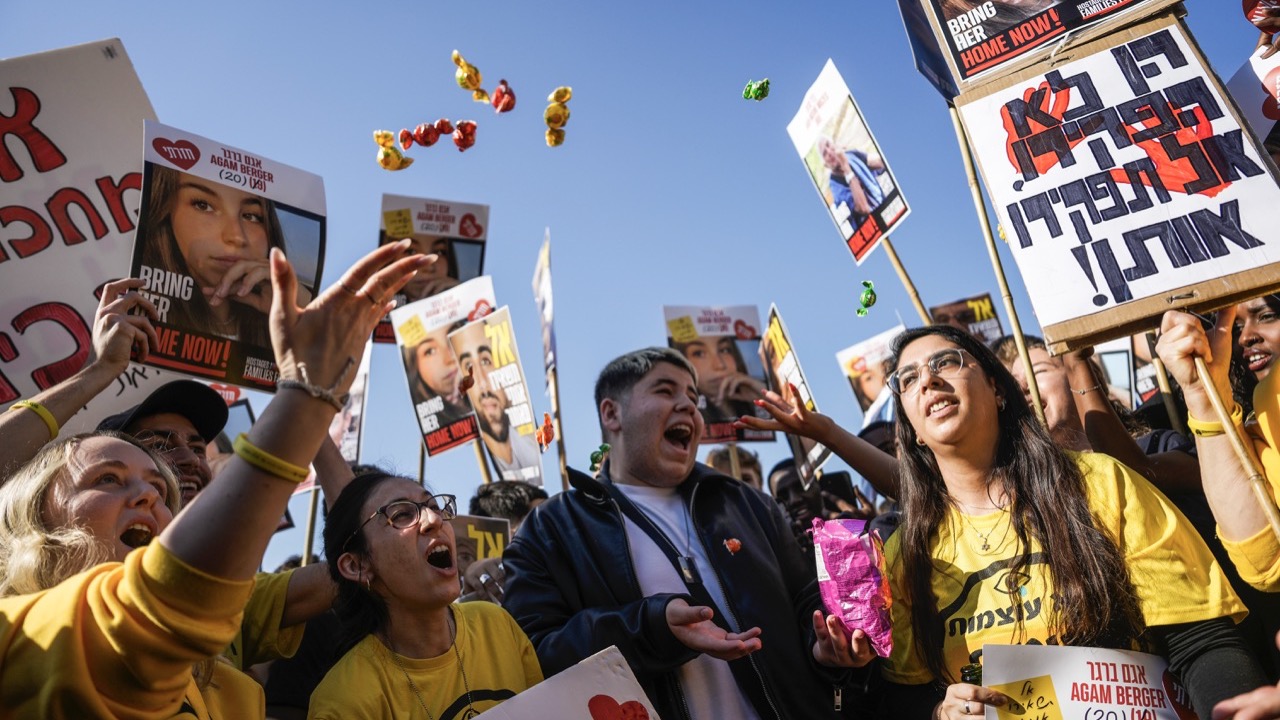Hostage release marred by chaotic scenes as Israel-Hamas ceasefire enters second week, with challenges ahead. (AP/Oded Balilty)

- Hamas releases eight hostages amid chaotic scenes, drawing protest from Israel over handover process.
- Netanyahu halts Palestinian prisoner release, demands assurances for safe hostage exits in future exchanges.
- Ceasefire enters second week as negotiations continue for release of remaining hostages and extended truce.
Share
KHAN YOUNIS, Gaza Strip — A line of white buses carrying Palestinian prisoners set to be released Thursday left Ofer prison in the West Bank.
The buses made their way toward Beitunah, near the occupied West Bank City of Ramallah where relatives and celebrations awaited.
Israel was releasing 110 Palestinian prisoners on Thursday in exchange for Israeli hostages freed from Gaza. The prisoner-for-hostage swap marked the third round of exchanges as a ceasefire deal between Israel and Hamas entered its second week.
Hamas Frees Eight Hostages Amid Chaotic Handover
Hamas-led militants freed eight hostages on Thursday as part of the ceasefire in the Gaza Strip, but the chaotic handover of some of the captives, who were shuttled through a rowdy crowd of thousands by masked militants, drew an angry protest from Israel.
Israel’s plans to release 110 Palestinian prisoners later in the day were put on hold by Prime Minister Benjamin Netanyahu, who demanded that mediators assure the safe exit for hostages going forward. He said later that he had received that commitment, and Israeli media reported the releases would go ahead.
Hamas released seven of the hostages in front of the destroyed home of its slain leader, Yahya Sinwar, as thousands pressed in. The militant group called it a “message of determination,” but it triggered the latest in a series of disputes that have sent U.S. and Arab mediators scrambling to patch up the truce.
Related Story: FACT FOCUS: No Evidence That $50 Million Was Designated by the US to Buy ...
Dramatic Scenes as Hostages Are Released
The first hostage — female soldier Agam Berger, 20 — was released after Hamas paraded her in front of a smaller crowd in the heavily destroyed urban Jabaliya refugee camp in northern Gaza.
Hours later, a chaotic scene unfolded at a handover of the other seven in the southern city of Khan Younis. Hundreds of militants from Hamas and the smaller Islamic Jihad group arrived with a convoy, and thousands of people gathered to watch, some from the tilted rooftops of bombed-out buildings.
Footage showed hostage Arbel Yehoud, 29, looking stunned as masked militants hustled her through the shouting crowd, pushing people back. Also released were Gadi Moses, an 80-year-old Israeli man, and five Thai laborers, identified by Israel as: Watchara Sriaoun, 33; Pongsak Thaenna, 36; Sathian Suwannakham, 35; Surasak Rumnao, 32; and Bannawat Saethao, 27.
Related Story: Hamas Will Free 3 Israelis and 5 Thais in Next Hostage Release Thursday
Ceasefire Holds but Challenges Ahead
In the first phase of the ceasefire, Hamas is set to release a total of 33 Israeli hostages, including women, children, older adults and sick or wounded men, in exchange for nearly 2,000 Palestinian prisoners. Israel says Hamas has confirmed that eight of the hostages to be released in this phase are dead.
The deal calls for Israel and Hamas to negotiate a second phase in which Hamas would release the remaining hostages and the ceasefire would continue indefinitely. The war could resume in early March if an agreement is not reached.
Israel says it is still committed to destroying Hamas, even after the militant group reasserted its rule over Gaza within hours of the truce. A key far-right partner in Netanyahu’s coalition is already calling for the war to resume after the ceasefire’s first phase.
Hamas says it won’t release the remaining hostages without an end to the war and a full Israeli withdrawal from Gaza.
The Israeli offensive has transformed entire neighborhoods into mounds of gray rubble, and it’s unclear how or when anything will be rebuilt. Around 90% of Gaza’s population has been displaced, often multiple times, with hundreds of thousands of people living in squalid tent camps or shuttered schools.
RELATED TOPICS:
Categories

MAHA Activists Urge Trump to Fire His EPA Administrator

Meta Strikes Multiple AI Deals With News Publishers

















